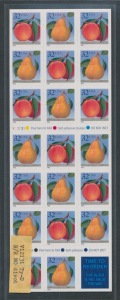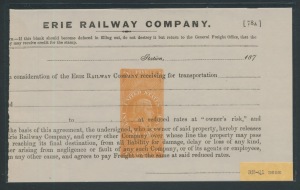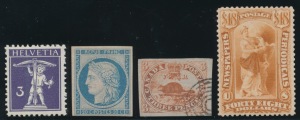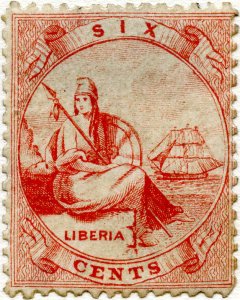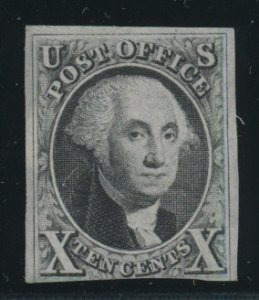Monthly Archives: March 2018
- Posted March 30, 2018Read more »One of the more ironic things about specialized philately is that collectors are far more likely to collect older issues in a highly specialized degree than they are to collect more modern stamps in the same degree of detail. Penny Blacks are specialized by plate number. There were 12 plates- each of which can only be told by detailed examination against known plated stamps) and 240 positions on each sheet (one for each set of check letters) making 2880 collectible stamps of the first postage stamp alone. Of the Penny Red of 1841, the second GB stamp, there are tens of thousands of different collectible varieties. Collectors of modern stamps usually collect only one of each, but this is out of habit. Many collectible varieties of modern stamps exist, and collectors of United States should be aware of this. The decision of how specialized to make your collection is yours alone, but this decision is easier to make if you are informed about varieties that are available.
- Posted March 29, 2018Read more »The specialty area of United States Revenues may be the most fertile collecting specialty for collectors. Scott lists the general issue revenues which are interesting enough. But it is in the field of the specialty revenues where collectors have had the most fun. There are specialty Revenues for everything from Perfume Tax Stamps to Consular Office Revenues (which paid the tax on things like passports and visas), to even Marijuana Tax Stamps (which paid a tax on the illegal drug). Incidentally, Marijuana Tax Stamps were declared unconstitutional by the the Supreme Court as a form of self incrimination since it was illegal to sell marijuana without buying the stamps and paying the tax. But since it was illegal to sell pot anyway, this was ruled law enforcement double dipping. There are over thirty specialty revenues that the Scott catalog lists, and scores more of Scott unlisted revenue types— most of which are called "Tax Paids" and are excluded
- Posted March 27, 2018Read more »
 Probably the best philatelic magazine that is published anywhere in the world is the "The American Philatelist", which is the monthly journal of the American Philatelic Society. Over eighty pages each month, the magazine serves partly as a member bulletin. But the real interest each month is the numerous detailed articles written by members, mostly about their collections and collecting interests.Philatelic scholarship has morphed over the years and "The American Philatelist" has been leading the change. This transformation has been the work of the editor of "The American Philatelist", Barbara Boal. Years ago, articles in philatelic journals carried titles like "A Study of the Cameos of the 1851 Portugal Dom Pedro's". These articles
Probably the best philatelic magazine that is published anywhere in the world is the "The American Philatelist", which is the monthly journal of the American Philatelic Society. Over eighty pages each month, the magazine serves partly as a member bulletin. But the real interest each month is the numerous detailed articles written by members, mostly about their collections and collecting interests.Philatelic scholarship has morphed over the years and "The American Philatelist" has been leading the change. This transformation has been the work of the editor of "The American Philatelist", Barbara Boal. Years ago, articles in philatelic journals carried titles like "A Study of the Cameos of the 1851 Portugal Dom Pedro's". These articles - Posted March 23, 2018Read more »Look for stories about the deteriorating relationship between Japan and China to be in the news over the next year. The two countries have a dispute over some islands in the China Sea, and the Japanese recently elected a far more aggressive government to deal with the perceived Chinese threat to Japanese interests. The Chinese are reacting to the feeling that the Japanese have long taken advantage of them. The chances are that this dispute will simmer along below the boiling point, mostly because both countries do so much business together, and they have so much to lose if the confrontations go beyond the verbal stage. But face must be saved, and should this area heat up beyond words, it wouldn't be the first time in history that countries put pride before self interest.
- Posted March 22, 2018Read more »
 The original format in which stamps were issued was full sheets. As time went on, postal authorities began to produce stamps for sale in more convenient formats for postal users. In the era before postage meters (and now, pre-printed postage indices), coil stamps were issued as the preferred method of stamp purchases for large mailing houses. Issued in rolls (sometimes up to as many as 10,000 in a single roll), the mailing houses could place these large rolls in their mailing machines and lower their labor costs as these stamps were automatically affixed. Individuals could buy coils, too (and some countries, such as Sweden largely had coils as their preferred method of stamp production), but for the most part coils were produced mainly for business use.Booklets
The original format in which stamps were issued was full sheets. As time went on, postal authorities began to produce stamps for sale in more convenient formats for postal users. In the era before postage meters (and now, pre-printed postage indices), coil stamps were issued as the preferred method of stamp purchases for large mailing houses. Issued in rolls (sometimes up to as many as 10,000 in a single roll), the mailing houses could place these large rolls in their mailing machines and lower their labor costs as these stamps were automatically affixed. Individuals could buy coils, too (and some countries, such as Sweden largely had coils as their preferred method of stamp production), but for the most part coils were produced mainly for business use.Booklets - Posted March 20, 2018Read more »
Stamp design and messaging has changed over the course of the last one hundred years. For most of the nineteenth century, stamp design was simple and rarely changed. New issues were uncommon and Commemoratives unheard of. Design was meant to identify the label quickly as an official government item, a bearer bond so to speak, which indicated a prepaid service of a certain amount. The denomination needed to be clearly indicated (and most countries used color coding to help with denomination recognition- on US stamps the first class (3c) rate was red and the transcontinental rate (10c) was green), and the design needed to indicate the country of origin.Every country except Great Britain has always put its name on its postage stamps. But even in - Posted March 19, 2018
- Posted March 16, 2018Read more »
 Readers of this blog are aware by now of how fashions change in philately. Used stamps were comparatively more popular fifty years ago than they are today. Covers and postal history were essentially uncollected until about 1920, had their peak around 1980, and have since fallen to a secure but niche collecting status. Blocks and multiples were once part of everyone's collection; today a single will do.No change in philatelic tastes though has been more profound than the current affection for original gum on Nineteenth Century stamps. One hundred years ago, collectors were routinely instructed to wash the gum off of their mint stamps. Early postage stamp gums were organically based and prone to bacterial infestation which shows up as "foxing"
Readers of this blog are aware by now of how fashions change in philately. Used stamps were comparatively more popular fifty years ago than they are today. Covers and postal history were essentially uncollected until about 1920, had their peak around 1980, and have since fallen to a secure but niche collecting status. Blocks and multiples were once part of everyone's collection; today a single will do.No change in philatelic tastes though has been more profound than the current affection for original gum on Nineteenth Century stamps. One hundred years ago, collectors were routinely instructed to wash the gum off of their mint stamps. Early postage stamp gums were organically based and prone to bacterial infestation which shows up as "foxing" - Posted March 15, 2018Read more »
 In the 1940s and 1950s, the terror of the philatelic world was Elliot Perry. Perry was a knowledgeable philatelist but a personal horror. Every philatelic dispute was to him a holy crusade. A suggestion that his opinion wasn't formed on Olympus enraged him to the point that he never forgave the miscreant who doubted him. He had a dispute with Harry Konwiser, another prominent philatelist, that may have started over a Confederate cover, but as was clear in their telling of it, neither retained much sense over what the dispute was originally about. The conflagration lasted decades and was public and acrimonious in the extreme. Perry made himself unassailable, not so much because he was so knowledgeable, but because he made the public price of disagreeing with him so very high. Eventually Perry passed on and is little remembered anymore.
In the 1940s and 1950s, the terror of the philatelic world was Elliot Perry. Perry was a knowledgeable philatelist but a personal horror. Every philatelic dispute was to him a holy crusade. A suggestion that his opinion wasn't formed on Olympus enraged him to the point that he never forgave the miscreant who doubted him. He had a dispute with Harry Konwiser, another prominent philatelist, that may have started over a Confederate cover, but as was clear in their telling of it, neither retained much sense over what the dispute was originally about. The conflagration lasted decades and was public and acrimonious in the extreme. Perry made himself unassailable, not so much because he was so knowledgeable, but because he made the public price of disagreeing with him so very high. Eventually Perry passed on and is little remembered anymore. - Posted March 12, 2018Read more »
 Throughout philatelic history, writers have been predicting the next great philatelic area or specialty that will take off in price. Predictions are usually founded on one of two criteria that predict the supposed increase in popularity that the stamps will undergo. Either the economy of the country will take off creating a pool of desperate collectors eager to buy the older issues that you should have put away (if only you had listened to the prognosticator), or there is some intrinsic not fully understood rarity factor that collectors will ultimately discover which will make them eager to buy stamps that you (had you listened to the prognosticator) should have put away in quantity. The problem with predictions is that they tend to be very accurate in hindsight, and we tend to forget all the ones that haven't panned out. For the last fifty years, Brazil was always going to be the next best country. The economy was going to boom, and 120 million Brazilian collectors would enter the
Throughout philatelic history, writers have been predicting the next great philatelic area or specialty that will take off in price. Predictions are usually founded on one of two criteria that predict the supposed increase in popularity that the stamps will undergo. Either the economy of the country will take off creating a pool of desperate collectors eager to buy the older issues that you should have put away (if only you had listened to the prognosticator), or there is some intrinsic not fully understood rarity factor that collectors will ultimately discover which will make them eager to buy stamps that you (had you listened to the prognosticator) should have put away in quantity. The problem with predictions is that they tend to be very accurate in hindsight, and we tend to forget all the ones that haven't panned out. For the last fifty years, Brazil was always going to be the next best country. The economy was going to boom, and 120 million Brazilian collectors would enter the - Posted March 09, 2018Read more »
Earl P.L. Apfelbaum opened for business full time in 1930 in downtown Philadelphia. He began his business during the Great Depression and started by selling out of his own stamp collection. His business and his stock grew and grew, and by 1950, the Apfelbaum stamp firm had opened a large office on South Penn Square, opposite Philadelphia's city hall in which we had one of the largest retail stamp stores in the United States. There were thousands of books of stamps neatly arranged by country and Scott number in the price range of 25 cents to several hundred dollars per item. There were hundreds of boxes of individually priced covers arranged by country. Clients from around the world would stop in and spend an afternoon or even a few days. Once a German fellow came in while on vacation and was so enamored of the thousands of items that he could peruse that he sent the rest of his family back to Berlin and stayed for over a week.
- Posted March 06, 2018Read more »
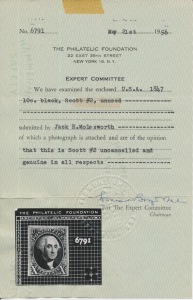 Stamp certification never provides absolute certainty to stamp buyers. Expert committees in the United States are very clear that they offer only an opinion, not a guarantee. Their legal boilerplate, which every owner signs when he commits his stamps
Stamp certification never provides absolute certainty to stamp buyers. Expert committees in the United States are very clear that they offer only an opinion, not a guarantee. Their legal boilerplate, which every owner signs when he commits his stamps - Posted March 05, 2018Read more »
Stamps have been written about since they first started being collected (for over 150 years now) so any avid philatelic reader has millions of philatelic words to brighten his cold winter evenings. Over time, readers have realized that stamp writing comes in four major types. Each collector has his favorite type and writers rarely write in more than one of these different philatelic genres.
 The first major type of stamp writing, the largest in terms of words written and books and articles published in the more high-brow journals, is technical writing. The first issue of the London Philatelist, published in 1892, had
The first major type of stamp writing, the largest in terms of words written and books and articles published in the more high-brow journals, is technical writing. The first issue of the London Philatelist, published in 1892, had - Posted March 02, 2018Read more »Throughout the Nineteenth Century, postal officials around the globe had one paranoia in common: they feared that postal patrons were soaking used stamps off envelopes, washing the cancellations, and then reusing the stamps. Philatelists who have studied thousands of stamps from the period have found scant evidence of this fraud. But that didn't keep postal authorities from devising more and more detailed plans to discourage such illegal reuse. The anti-reuse hysteria reached its apex with the grilled issues of 1867.Grills are tiny cuts made in the paper of a stamp. The stamps were printed, gummed, and, before the perforation process, fed into a device that looks like a printing press but which has metal cutting heads that make a small group

